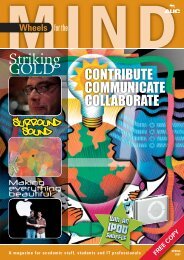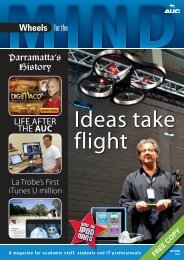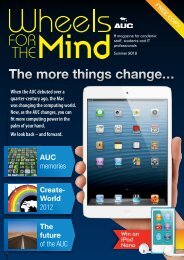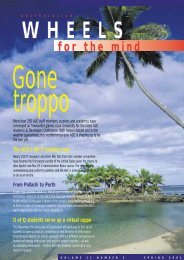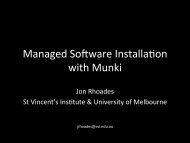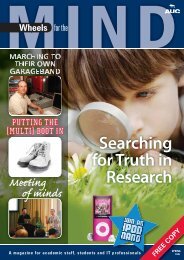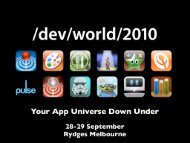for the mind - AUC
for the mind - AUC
for the mind - AUC
You also want an ePaper? Increase the reach of your titles
YUMPU automatically turns print PDFs into web optimized ePapers that Google loves.
Oriental flavours<br />
By David Braue<br />
Ka<strong>the</strong> Kirby (left) and Meredith Hinze, pictured with <strong>the</strong> recent Luo Bro<strong>the</strong>rs’ lacquer<br />
paintings exhibit, see a growing role <strong>for</strong> technology in Asian-Australian art exchanges<br />
The year-old Sidney Myer Asia<br />
Centre provides a focal point <strong>for</strong><br />
Asian art and cultural studies<br />
Having painted Australia’s relationship with Asia in exclusively<br />
political and economic terms, <strong>the</strong> mainstream media has<br />
marginalised <strong>the</strong> o<strong>the</strong>r facets of our complex interactions. Seeking<br />
to bring many of those facets to <strong>the</strong> <strong>for</strong>efront, <strong>the</strong> Asialink Centre<br />
– a non-academic centre within <strong>the</strong> University of Melbourne – has<br />
been using multimedia technology to bridge <strong>the</strong> gaps with our<br />
Asian neighbours.<br />
This bridging has come in many <strong>for</strong>ms. Asialink drives a number<br />
of high-profile programs such as <strong>the</strong> Commonwealth governmentbacked<br />
Asia Education Foundation, which promotes <strong>the</strong> study of<br />
Asian cultures in Australian schools. Regular Asian tours of<br />
contemporary Australian art are organised by <strong>the</strong> Asialink Arts<br />
Program, which each year also provides 40 residencies <strong>for</strong><br />
Australian artists to spend three months each in <strong>the</strong> region.<br />
Ano<strong>the</strong>r program, Asialink MediaLink, facilitates three-month<br />
exchanges between Asian and Australian media organisations.<br />
Because it’s involved in so many projects, social networking is<br />
naturally a major part of Asialink’s work. But by leveraging a<br />
number of multimedia technologies, <strong>the</strong> 25-person organisation<br />
has been able to significantly expand its reach and facilitate a<br />
number of communication <strong>for</strong>ums that would never have o<strong>the</strong>rwise<br />
been possible.<br />
One such project is Asia EdNet, a moderated online discussion<br />
group that helps more than 1000 Australian teachers share<br />
in<strong>for</strong>mation related to Asian studies. Then <strong>the</strong>re’s Access Asialink,<br />
a weekly newsletter that broadcasts in<strong>for</strong>mation about Asiarelated<br />
activities in Australia to 3000 subscribers.<br />
Artists affiliated with Asialink rely heavily on digital technology<br />
to create and distribute both images and video, and Asialink has<br />
also been involved in a number of educational Web sites (to<br />
considerable success: in 1999, its China section won <strong>the</strong><br />
Australian Publishers’ Association’s Best Designed Web Site of <strong>the</strong><br />
Year award, while its Indonesia <strong>for</strong> Kids section won a 2000<br />
award <strong>for</strong> excellence in educational publishing). Asialink is<br />
currently partnering with <strong>the</strong> Art Gallery of Queensland to<br />
develop a Web site <strong>for</strong> year 11 and 12 students focused around<br />
<strong>the</strong> upcoming Asia Pacific triennial in Brisbane.<br />
Technology “has enormously changed our capacity to share<br />
in<strong>for</strong>mation and resources, and enhanced our ability to support<br />
and reach out to teachers,” says Asialink deputy director Ka<strong>the</strong><br />
Kirby. “Increasingly, Australian artists are working with <strong>the</strong>ir<br />
colleagues in <strong>the</strong> Asian region, and <strong>the</strong>re’s a lot of talk about<br />
collaborative online projects.”<br />
One such project, <strong>for</strong> example, was a recent experiment by<br />
professional dance troupe<br />
Company in Space in which two<br />
dancers, thousands of kilometres<br />
apart, met in cyberspace and<br />
per<strong>for</strong>med toge<strong>the</strong>r. Dancers in<br />
Melbourne and Hong Kong were<br />
Webcast simultaneously, with <strong>the</strong>ir<br />
live video images combined on a<br />
large projection screen to give <strong>the</strong><br />
effect that <strong>the</strong>y were dancing in<br />
<strong>the</strong> same room.<br />
Although a number of historical<br />
reasons had previously <strong>for</strong>ced<br />
Asialink to abandon its Macintosh<br />
systems in favour of Windows<br />
systems, <strong>the</strong> pendulum has swung<br />
back again as those machines<br />
neared <strong>the</strong> end of <strong>the</strong>ir lives.<br />
Dance troupe<br />
Asialink entered new premises, in<br />
Company in<br />
<strong>the</strong> modern Sidney Myer Asia<br />
Space used <strong>the</strong><br />
Centre, last year, and last month<br />
Internet to link<br />
dancers in<br />
cut its technology ties with <strong>the</strong> past<br />
Melbourne and<br />
by replacing all of its Windows<br />
Hong Kong<br />
machines with iMacs.<br />
Asialink now has 26 brand<br />
spanking new 700MHz iMacs, each having 15” or 17” flat<br />
screens that IT manager Meredith Hinze says have proven both<br />
technologically sound, and much better suited to <strong>the</strong> often<br />
glaringly lit environs of <strong>the</strong> new building.<br />
“I was very much keen to push Macs because of <strong>the</strong> reliability<br />
and <strong>the</strong> hardware,” explains Hinze, <strong>the</strong> organisation’s sole IT<br />
person. “We tested eMacs, but <strong>the</strong> building is extremely glary and<br />
it wasn’t a great improvement over our current CRT monitors. We<br />
really thought <strong>the</strong> iMacs were <strong>the</strong> best option due to <strong>the</strong> flexibility<br />
of <strong>the</strong> screens.”<br />
The iMacs are running MacOS 10.2.1, whose dramatically<br />
improved Windows compatibility has helped Hinze seamlessly<br />
link <strong>the</strong> new desktops into <strong>the</strong> centre’s back-end Windows NT 4<br />
server (shared with several o<strong>the</strong>r departments).<br />
“Getting <strong>the</strong> Mac equipment here shows us <strong>the</strong> things we might<br />
be able to do with our own Web site and will inspire us to be more<br />
creative in that area,” says Kirby. “We’re always interested in<br />
promoting Australian artists using <strong>the</strong> latest technologies.”<br />
For more in<strong>for</strong>mation, see www.asialink.unimelb.edu.au<br />
AUSTRALASIAN WHEELS FOR THE MIND 15



